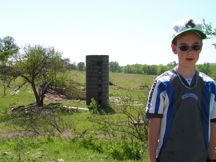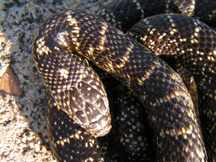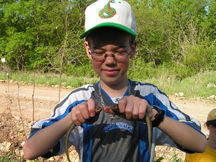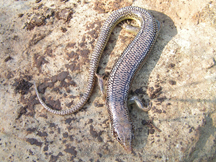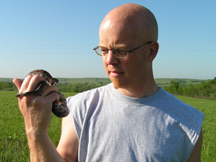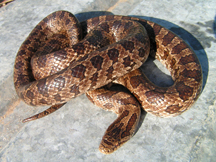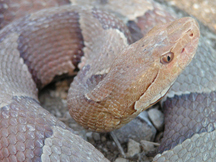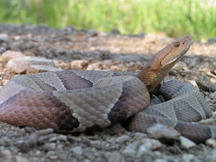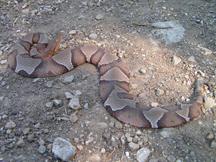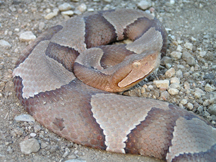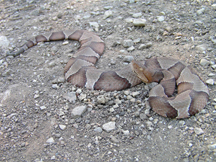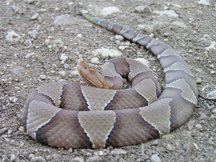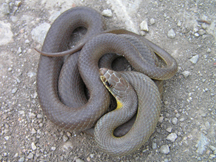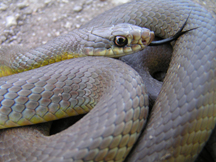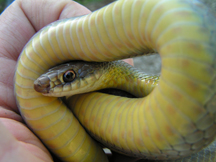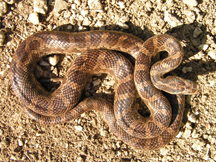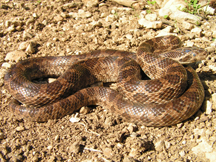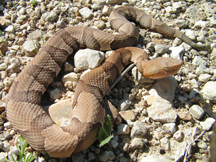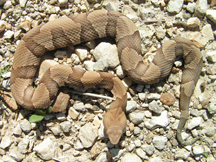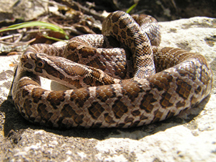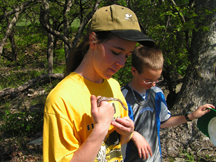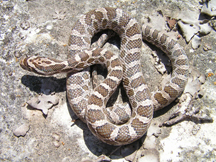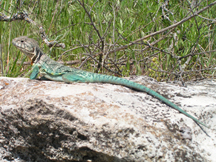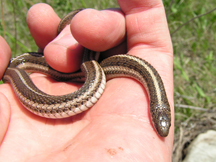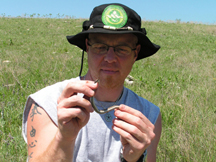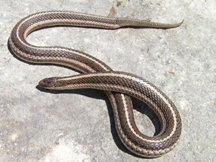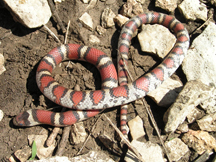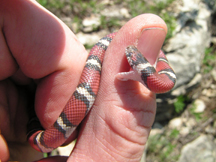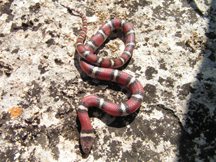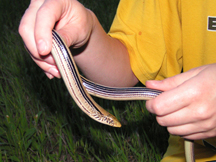
5-07-04
Trip Details
Location: Wabaunsee and Franklin Counties, Kansas
Conditions: Sunny and warm. High of about 90 degrees.
Time: 9:00 am to 9:00 pm
Herpers: Jim, Laura & Austin Scharosch
Laura, Austin and I started out the day in Wabaunsee County, Kansas. Today was going to be a test day for Austin. This is his first trip to Kansas, and I want him to identify everything we find. We knew it was going to get hot quickly today, so we got a fairly early start, and headed out to some areas we knew had tin to flip. On hot days you want to get to the tin early, as it heats up too much to hold anything later in the day. The first place we went to was an abandoned farmstead that we have checked for many years. It has never been a real snake hotspot, but we have found a few things there and it is always worth checking. Today was no exception. It was about 8:00 am, and already 68 degrees. The third thing we flipped was a piece of tin and we turned up a small King Snake (Lampropeltis getula), about eighteen inches long.
It had a lot of the “ladder” pattern that the younger ones do, and was going into a shed. We took photos and returned it to its hiding spot. We turned up a few Ringnecks and Great Plains Skinks from this spot, then moved on. Austin managed to correctly ID everything we found at this site.
The next spot was a huge pile of tin that we have done well at in the past. We worked all of the best parts of the pile where we usually find stuff, and all we turned up was a couple of ringnecks and Great Plains Skinks (Eumeces obsoletus).
We were all kind of bummed, and got back in the truck. At the last second, we decided to stop and run out and check another tin pile in the middle of a field where we have never found anything. It ended up being a good decision, as we found a nice Prairie King Snake (Lampropeltis calligaster).
Austin hasn’t missed an ID yet either.
The next place we headed was a road cut where we have had good luck finding Copperheads the last few years. We got there at about 9:45 am, and checked the east face, where we usually find stuff, and we didn’t see much. There were not even ringnecks, where usually this site is full of them. When we reached the end of the east side, I turned an enormous rock, and there were three Copperheads (Agkistrodon contortrix), two smaller ones and one really large one. It was a chore to get them out from under the rock without squishing them, but we managed. The big one was about two feet long, and nice and fat.
Both of the smaller ones were about twelve inches long.
First small copperhead
Second small copperhead
Austin didn’t get to ID these, as we yelled it out when we found them. I’m sure he would have gotten these right, a copperhead is pretty easy to distinguish from anything else. We let them head back under their rock and started to turn stuff on the west side of the road. After a couple of rocks, I turned a large flat rock and saw two snakes. One I knew right away was a Yellow Bellied Racer (Coluber constrictor).
It was about fourteen inches long. Austin called the ID on it right away. The second snake was blotched, and as soon as I determined it wasn’t a Massasauga, I grabbed it without looking to closely at it. Laura or I, I am not sure which, identified it as another Prairie King. I handed it to Austin and started to take pictures of the racer. When I was ready to start taking pictures of the Prairie King, I looked at it and Laura and I both realized at exactly the same time, that it was a Great Plains Rat Snake (Elaphe emoryi), about two and a half feet long.
It was going into a shed and the coloration was very dark, and the pattern on the back looked a lot like a prairie king. We were very happy that it was a Great Plains Rat, as we haven’t found a live one in the Flint Hills for a few years. It wasn’t really pretty since it was going into shed, but it was still cool to find one.
We moved on, looking for some new areas. We found a small road cut near a creek, and decided to stop and turn a couple rocks. A few rocks in, we turned up another Copperhead.
This one was about ten inches long. After photos, a couple rocks later, we found a second Great Plains Rat Snake.
This one was smaller, maybe fourteen inches long, but it wasn’t shedding and the pattern was really nice. I was happy to find it after finding the dark one earlier. This one was wedged between two rocks near the road. I have always had a thing for these snakes, as our first ever trip to the Flint Hills in Kansas the first two snakes we found were Great Plains Rats. We even raised them for a while.
We started driving again, and about 12:30 pm, we stopped at an old barn site. We figured it was worth a look, but when we got there we found the bane of herpers, a neat landowner. All of the tin from the collapsed barn roof was in two neat piles with rocks on top to keep them from blowing away. After this disappointment, we decided to go ahead and turn some rocks on the ridge. It was obvious this was the year for Great Plains Rat Snakes, as it only took a few minutes of rock turning to turn up another one.
This one was almost a duplicate of the last one, but maybe a little bit darker. Even though this was third one of the morning, it wasn’t getting old finding them. Laura spotted a nice, bright male Collared Lizard (Crotaphytus collaris) posing on top of big rock, and it let me get pretty close, so I took a couple pictures.
We decided to take a break for lunch, and then drive to some new areas to scout. The new roads we drove didn’t really pan out, so we headed to a spot where we find Lined Snakes each trip. True to form, the first rock I turned right by the truck had a Lined Snake (Tropidoclonion lineatum) under it.
It was a nice sized one, and of course, like all Lined Snakes, it didn’t want to pose for a decent picture. Farther up the hill, Laura turned up a nice yearling Milk Snake (Lampropeltis triangulum).
It was going into shed, but was still pretty cool. Austin found a few ringnecks, and farther along the rise I found another yearling Milk Snake, just like the other one, going into a shed. It was about 90 degrees, hot enough that nothing wanted to pose for pictures. All this Milk Snake wanted to do was bite on my fingers.
We decided to hit the road and head to the area we were going to herp the next morning. After getting our hotel, we drove out to the herp area and drove around. We stopped at a road cut and flipped a few rocks and found nothing but a few skinks. While walking back to the truck, I saw something dashing thru the grass and made a dive to catch it. Just before I grabbed, I figured out it was a Slender Glass Lizard (Ophisaurus attenuatus).
This was a great catch for us, because while they are not really uncommon in Kansas, we haven’t seen a lot of them. It struggled for a while after I caught it, then settled down. Then it dropped its tail. I had been as careful as I could with it, hoping it would not decide to do this. Many lizards do this as a defense mechanism, hoping the wiggling tail lying on the ground will distract predators from grabbing the escaping lizard. I hate when they do it, especially the Glass Lizards.
It was a cool addition, and a nice way to end the day. We headed back to the hotel with high hopes for the next day.

